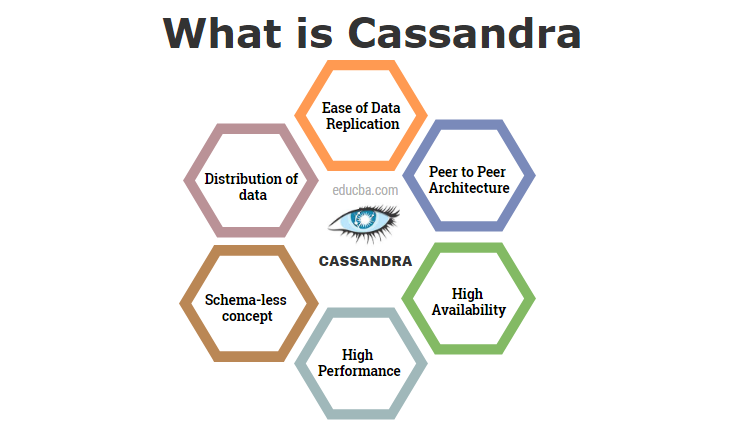Updated May 22, 2023

Introduction to Cassandra
Cassandra is an open-source database application from Apache, which doesn’t require SQL to fetch, view, update, or delete the database or the data. Hence it is known as a NoSQL type of database application. This database can be accessed and administered remotely and directly from various nodes. It is famous for its exclusive features like higher performance, flexibility for expansion and scalability, lower user latency, peer-to-peer architecture, no schema for structuring, significantly less effort and cost required for maintenance, faster processing, easy to learn & work on it, uncomplicated process for data copying, etc.
So what are Commodity Servers?
Well, in simple words, a Commodity Server is already available computing nodes or components for parallel computing. These Commodity Servers generally involve Commodity computing; many also know it as commodity cluster computing.
How does Cassandra make working so easy?
Working on this is relatively easy because of various reasons:
- Easy to understand
- Ease of using
- Big and better community
- Good documentation
All these things highly contribute towards the popularity and likeness of any software, and Cassandra has all these qualities to upvote for easiness of working rightly.
What can you do with Cassandra?
To answer this, let’s understand a typical requirement of a large-scale enterprise towards a database management system. Listing their general requirement majorly suffice on:
- Scalability
- High availability without compromising performance
- Linear scalability
- Proven fault-tolerance on commodity
- Low latency for users
A complete solution for all listed requirements is Cassandra. We can easily do and achieve all these things using Cassandra as our database management system.
Advantages
Below are the different advantages of Cassandra:
- Ease of data replication: It could easily replicate data deployed on any particular node if it has gone down when available
- Distribution of data: This could be used to store and locate data at various nodes, which has its great advantage
- Peer-to-peer architecture: It does not follow a typical master-slave concept but follows peer-to-peer architecture where every node participates equally with equal responsibilities. As a consequence of this, there is no single point of failure.
- High availability: Since there is no single point of failure, hence it is highly available around
- High Performance: It has to be very reliable for a big organization that generally deals with large-scale data
- Schema-less concept: Schema-less concept means that schema could be made internally as per our requirement
Required Skills?
Since we already know about this, I’m sure you are keen to learn the required skills.
Typically skills required could be broadly categorized in two ways:
- Tech skills requirement
- Conceptual skills required
A few of the significant but drastically important tech skills required to be a good Cassandra developer are:
- Concept of database
- Knowledge of NoSQL database
- Good to know about Java or any OOP language
On the conceptual front, you need to know about:
- Consistency levels – Generally, Cassandra stores data or typically copies of data at various remote locations; hence any change in data at a particular node needs to be updated and reflected at all nodes.
- Good sound knowledge of algorithms
- Know how data is written to memory and disk, where speed matters a lot
All the advantages, as discussed in the above section, are self-explanatory to withstand why to use Cassandra.
Scope for Using Cassandra
As stated earlier, everyone expects speed, zero tolerance, and high peer-to-peer communication database availability in modern digitization. It fulfills all these requirements; hence, its scope is relatively high, with hardly any subsequent competitor NoSQL database. Hence learning Cassandra is quite beneficial.
Why do We Need Cassandra?
We typically need Cassandra for the following reasons:
- Provides instant and simple solutions for complex problem – It provides a simple and efficient solution to complex things like logging and metrics collection. It provides a simple, sleek, and elegant feature for centralized logging.
- Low maintenance overhead – Cassandra databases could run independently, reducing maintenance dependency.
- Low cost of maintenance – Since it hardly requires any maintenance, its price automatically boils down.
- Easy to learn – Typically, it takes less time to learn Cassandra and be ready for the production level. Also, it has many developers for community support and well-versed documentation, which further ease learning curves.
- Fast read and write feature – Reading and writing on Cassandra disks are relatively fast and feasible.
Who is the right audience for learning Cassandra technologies?
It is for everyone. Anyone interested in the NoSQL database is welcome to learn this smart technology. People involved in database designing, big data handling, database designers, and developers are open to learning this technology.
How will this technology help you in career growth?
This technology is growing rapidly and is in demand relatively high. Even big organizations are coming forward to use and deploy this technology for their business requirements.
Hence learning this relatively new technology will be a significant boost for everyone involved in some other ways. Also, its increasing demand and large-scale scalability are causing it to get more and more demand.
Conclusion
Learn this new and fascinating technology as it has quite a good scope ahead. Its ease of scalability, rising demand, zero-tolerance against database failure, remote data distribution across various nodes, and peer-to-peer concept will take this technology ahead.
Also, easier reading and writing on a relatively fast disk provides additional advantages over others.
Recommended Articles
This has been a guide to What is Cassandra? Here we discussed the basic concept, working, skills, scope, Cassandra’s advantages, and career growth. You can also go through our other suggested articles to learn more –

